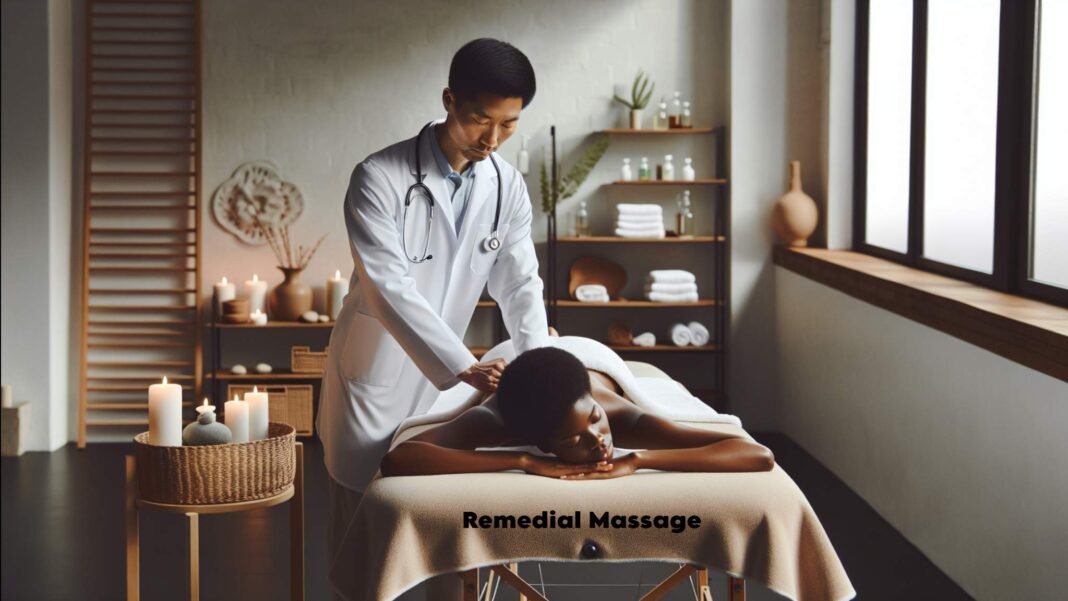Remedial massage is recognized as a complementary therapy that targets problems affecting muscles, tendons, and bones, aiming to treat not just the symptoms but the underlying cause of the issue. Despite its benefits, it’s important to note that it should not replace medical care from a doctor but serve alongside it to manage symptoms more effectively. This natural therapy varies in its application, from strong and deep pressure to gentle and shallow touches, based on the patient’s specific problem.
It is adept at providing relief for a variety of ailments including, but not limited to, neck, shoulder, and back pain, muscle cramps, sports injuries, headaches, chronic pain conditions such as arthritis and frozen shoulder, and even non-physical conditions like anxiety and depression. Moreover, remedial massage has shown to offer benefits in addiction rehabilitation, easing the side effects of cancer treatments, preventing injuries, and assisting in the weight gain of premature babies, highlighting its versatility as a treatment method. This article will delve into understanding remedial massage, outlining common conditions it can treat, techniques used, how to choose the right therapist, and what to expect in a session, ensuring readers are well-informed on this beneficial complementary therapy.
Understanding Remedial Massage
Remedial massage is a therapeutic technique that addresses specific issues within the musculoskeletal system. It employs various hands-on methods to manipulate the muscles, tendons, and ligaments, aiming to rehabilitate physical injuries and improve health conditions. Techniques such as effleurage (long, sweeping strokes), petrissage (kneading), and friction are commonly used to enhance circulation and repair tissue damage. This form of massage is not only about relaxation but is specifically tailored to prevent and treat injuries, making it an integral part of pain management and rehabilitation plans.
Key Techniques and Their Benefits
- Effleurage: Enhances blood circulation and prepares the muscles for deeper massage techniques.
- Petrissage: Increases blood flow, which facilitates the removal of toxins and helps in muscle recovery.
- Friction: Generates heat to relieve muscular tension and break down adhesions in muscle fibers.
- Stretching and Joint Movements: Improves flexibility and increases the range of motion.
Remedial massage therapists are trained to perform assessments that help in identifying the underlying causes of musculoskeletal issues. They use this information to apply specific techniques that target particular areas, providing relief and aiding in the body’s natural healing process. The therapy is known for its effectiveness in treating conditions such as chronic back pain, arthritis, and sports injuries, among others. It can also assist in mental health management by reducing stress and anxiety, contributing to an overall sense of well-being. For those looking for additional recovery options, exploring complementary therapies such as IV therapy can further enhance this holistic health approach.
Common Conditions Treated
Remedial massage effectively addresses a broad spectrum of physical and psychological conditions. It is particularly beneficial for musculoskeletal issues and chronic pain management. Here are some of the key conditions that remedial massage can help alleviate:
- Musculoskeletal Imbalances: Including chronic back and neck pain, sports injuries, and postural issues which often lead to restricted movement and pain.
- Chronic Pain and Acute Injuries: Effective in managing pain from arthritis, repetitive strain injuries (RSI), and conditions like sciatica and carpal tunnel syndrome.
- Soft Tissue Injuries and Nerve Compression: Helps in treating conditions such as whiplash, frozen shoulder, and tendinitis by relieving muscle tension and improving blood circulation.
Additionally, remedial massage supports recovery from non-physical issues:
- Psychological Conditions: Provides relief from stress, anxiety, and depression, enhancing overall mental health and well-being.
- Rehabilitation and Recovery: Aids in addiction rehabilitation and helps mitigate the side effects of cancer treatments.
- Developmental Support: Shows potential in assisting premature babies to gain weight and in improving conditions caused by developmental and postural issues.
By targeting specific areas with appropriate techniques, remedial massage not only relieves pain but also promotes healing and improves quality of life.
Techniques and Modalities
Remedial massage incorporates a variety of techniques to address specific physical issues, enhancing overall well-being. Techniques such as deep tissue massage, trigger point therapy, and myofascial release are pivotal in treating deeper layers of muscle and connective tissues. These methods are designed to deactivate hyper-tense muscles, providing relief from chronic pain and improving conditions like repetitive strain injuries (RSI) and osteoarthritis.
Key Techniques in Remedial Massage:
- Deep Tissue Massage: Targets chronic muscle pain, enhances recovery from injuries, and aids in breaking up scar tissue.
- Trigger Point Therapy: Focuses on specific points of tension within the muscle, offering relief from pain and enhancing mobility.
- Myofascial Release: Involves stretching and releasing the bands of connective tissue, improving blood flow and easing pain.
Additionally, remedial massage employs thermotherapy and cryotherapy, which involve the application of heat and cold to reduce inflammation, ease pain, and accelerate recovery. Joint mobilization and stretch therapy are also utilized to improve flexibility and range of motion, further supporting the body’s natural healing processes. These techniques collectively help in managing conditions such as sciatica, improving postural issues, and assisting with the rehabilitation of sports-related injuries.
Choosing the Right Therapist
Identifying the right remedial massage therapist involves understanding your specific health needs and preferences. Start by considering what you aim to achieve with massage therapy, such as pain relief from sports injuries, stress management, or enhancement of general well-being. Once your goals are clear, factor in personal preferences like the therapist’s proximity to your home or workplace, gender, and level of experience.
How to Find a Great Massage Therapist
- Seek Personal Recommendations: Ask friends, family, or healthcare professionals for referrals to trusted therapists.
- Online Research: Check therapists’ websites and read online reviews to gauge past client satisfaction.
- Professional Associations: Look for therapists listed under reputable associations like the Association of Massage Therapists.
Essential Checks Before Choosing a Therapist
- Verify Credentials: Ensure the therapist has the necessary certifications, licenses, and is a member of professional associations.
- Discuss Needs and Expectations: Have an open conversation about your health concerns, their experience, and treatment philosophies.
- Consider Logistics: Check the therapist’s location, availability, pricing, and whether they offer health insurance benefits.
Choosing a therapist who is well-versed in remedial massage and specializes in addressing your specific health issues can significantly enhance the effectiveness of the therapy.
What to Expect During Your Appointment
Preliminary Assessments and Privacy Considerations
At the start of your remedial massage appointment, expect a thorough discussion with your massage therapist about your general health, medical history, lifestyle, stress levels, medications, and specific areas of physical discomfort. This initial conversation is crucial for tailoring the massage to your needs. Privacy is a priority; you will be asked to undress to your comfort level in private, and the therapist will ensure only the part of your body being worked on is uncovered during the session.
The Massage Environment and Session Details
Professional Interaction and Follow-Up
Professionalism is paramount in remedial massage therapy. Expect a relationship based on mutual respect, courtesy, and confidentiality. You have the right to dictate the level of conversation and background music, as well as to give consent to the massage techniques used. After the session, discuss a customized follow-up plan with your therapist to continuously address your health and wellness goals, leveraging the cumulative benefits of regular remedial massage.
Health Insurance and Remedial Massage
In Australia, remedial massage is recognized as a viable treatment option and is often included in the extras cover of private health insurance policies. To benefit from a health fund rebate for remedial massage, it is essential that your extras cover specifically includes this therapy. Once included, private health insurers generally pay a percentage of the costs associated with each remedial massage session, effectively reducing the out-of-pocket expense for the insured individual.
Coverage and Limits
- Combined Coverage: Remedial massage cover limits may be bundled with other complementary therapies such as acupuncture, with a maximum benefit cap applicable across all included therapies.
- Practitioner Requirements: Insurers mandate that benefits are only payable when services are rendered by recognized practitioners who have attained at least a diploma in remedial massage.
- Policy Details: Some health insurance policies may offer a combined annual limit that encompasses other natural therapies or treatments, which can affect the total benefit available for remedial massage.
According to findings from a Finder survey, remedial massage ranks among the top five extras that Australians deem crucial in their health insurance plans. This highlights the massage’s perceived value in contributing to overall health and wellness. When considering health insurance, it’s advisable to review the specifics of what each policy covers under therapy and massage to ensure it meets your health care needs and expectations.
Conclusion
Throughout this exploration of remedial massage, we’ve circled the profound benefits and various techniques that underscore its role as a complementary therapy. From mitigating chronic musculoskeletal pain to aiding in mental health management and supporting recovery in non-physical conditions, remedial massage presents a holistic approach to healing and wellness. Its versatility is further highlighted by its incorporation into health insurance plans, signifying its acknowledged value in maintaining and enhancing health.
In final reflection, choosing the right remedial massage therapist and understanding what to expect in a session are critical steps for anyone considering this therapy. As we’ve seen, its impacts stretch far beyond simple relaxation, weaving into the fabric of comprehensive health care. The significance of remedial massage, both in addressing specific health issues and in promoting overall well-being, illustrates a path forward for individuals seeking to harmonize their physical and mental health. This journey underscores the therapy’s overarching promise: to deliver tailored relief and support the body’s inherent healing processes.
FAQs About Remedial Massage:
What is remedial massage and what does it target?
Remedial massage is a complementary therapy targeting muscle, tendon, and bone issues, aiming to treat underlying causes. It’s not a replacement for medical care but complements it. The therapy varies from strong to gentle touches based on the patient’s specific problem.
What are the key techniques used in remedial massage and their benefits?
Key techniques include effleurage, petrissage, friction, stretching, and joint movements. Effleurage enhances blood circulation, petrissage increases blood flow, friction generates heat, and stretching improves flexibility. These techniques collectively aid in rehabilitation and pain management.
What are the common conditions effectively treated by remedial massage?
Remedial massage effectively addresses musculoskeletal imbalances, chronic pain, acute injuries, soft tissue injuries, nerve compression, psychological conditions, rehabilitation, recovery, and developmental support. It provides relief from conditions such as chronic back and neck pain, sports injuries, stress, anxiety, and depression, among others.
How can one find the right remedial massage therapist and what to expect during a remedial massage appointment?
Finding the right therapist involves seeking personal recommendations, conducting online research, and checking professional associations. During a remedial massage appointment, expect a thorough initial discussion, a tailored massage, a professional environment, and a follow-up plan. It’s also important to understand health insurance coverage for remedial massage.


